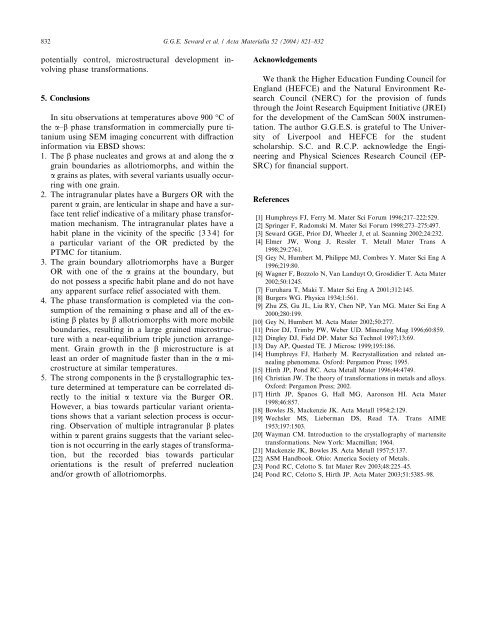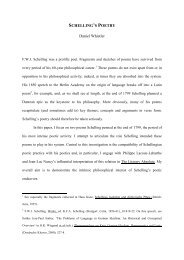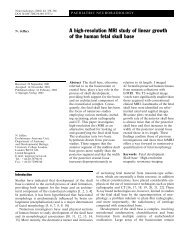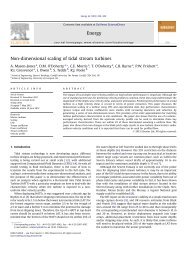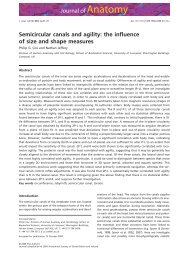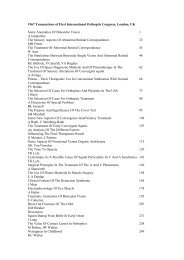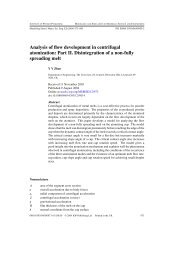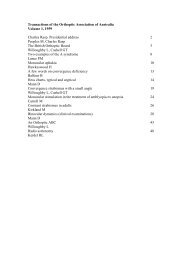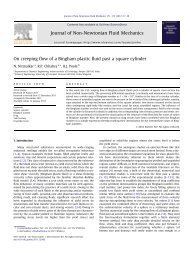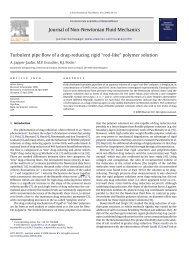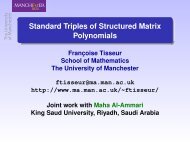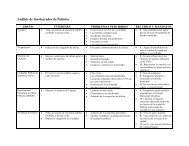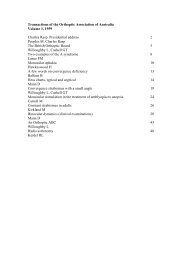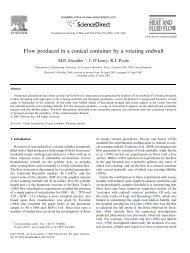In situ SEM-EBSD observations of the hcp to bcc phase ...
In situ SEM-EBSD observations of the hcp to bcc phase ...
In situ SEM-EBSD observations of the hcp to bcc phase ...
Create successful ePaper yourself
Turn your PDF publications into a flip-book with our unique Google optimized e-Paper software.
832 G.G.E. Seward et al. / Acta Materialia 52 (2004) 821–832potentially control, microstructural development involving<strong>phase</strong> transformations.5. Conclusions<strong>In</strong> <strong>situ</strong> <strong>observations</strong> at temperatures above 900 °C <strong>of</strong><strong>the</strong> a–b <strong>phase</strong> transformation in commercially pure titaniumusing <strong>SEM</strong> imaging concurrent with diffractioninformation via <strong>EBSD</strong> shows:1. The b <strong>phase</strong> nucleates and grows at and along <strong>the</strong> agrain boundaries as allotriomorphs, and within <strong>the</strong>a grains as plates, with several variants usually occurringwith one grain.2. The intragranular plates have a Burgers OR with <strong>the</strong>parent a grain, are lenticular in shape and have a surfacetent relief indicative <strong>of</strong> a military <strong>phase</strong> transformationmechanism. The intragranular plates have ahabit plane in <strong>the</strong> vicinity <strong>of</strong> <strong>the</strong> specific {3 3 4} fora particular variant <strong>of</strong> <strong>the</strong> OR predicted by <strong>the</strong>PTMC for titanium.3. The grain boundary allotriomorphs have a BurgerOR with one <strong>of</strong> <strong>the</strong> a grains at <strong>the</strong> boundary, butdo not possess a specific habit plane and do not haveany apparent surface relief associated with <strong>the</strong>m.4. The <strong>phase</strong> transformation is completed via <strong>the</strong> consumption<strong>of</strong> <strong>the</strong> remaining a <strong>phase</strong> and all <strong>of</strong> <strong>the</strong> existingb plates by b allotriomorphs with more mobileboundaries, resulting in a large grained microstructurewith a near-equilibrium triple junction arrangement.Grain growth in <strong>the</strong> b microstructure is atleast an order <strong>of</strong> magnitude faster than in <strong>the</strong> a microstructureat similar temperatures.5. The strong components in <strong>the</strong> b crystallographic texturedetermined at temperature can be correlated directly<strong>to</strong> <strong>the</strong> initial a texture via <strong>the</strong> Burger OR.However, a bias <strong>to</strong>wards particular variant orientationsshows that a variant selection process is occurring.Observation <strong>of</strong> multiple intragranular b plateswithin a parent grains suggests that <strong>the</strong> variant selectionis not occurring in <strong>the</strong> early stages <strong>of</strong> transformation,but <strong>the</strong> recorded bias <strong>to</strong>wards particularorientations is <strong>the</strong> result <strong>of</strong> preferred nucleationand/or growth <strong>of</strong> allotriomorphs.AcknowledgementsWe thank <strong>the</strong> Higher Education Funding Council forEngland (HEFCE) and <strong>the</strong> Natural Environment ResearchCouncil (NERC) for <strong>the</strong> provision <strong>of</strong> fundsthrough <strong>the</strong> Joint Research Equipment <strong>In</strong>itiative (JREI)for <strong>the</strong> development <strong>of</strong> <strong>the</strong> CamScan 500X instrumentation.The author G.G.E.S. is grateful <strong>to</strong> The University<strong>of</strong> Liverpool and HEFCE for <strong>the</strong> studentscholarship. S.C. and R.C.P. acknowledge <strong>the</strong> Engineeringand Physical Sciences Research Council (EP-SRC) for financial support.References[1] Humphreys FJ, Ferry M. Mater Sci Forum 1996;217–222:529.[2] Springer F, Radomski M. Mater Sci Forum 1998;273–275:497.[3] Seward GGE, Prior DJ, Wheeler J, et al. Scanning 2002;24:232.[4] Elmer JW, Wong J, Ressler T. Metall Mater Trans A1998;29:2761.[5] Gey N, Humbert M, Philippe MJ, Combres Y. Mater Sci Eng A1996;219:80.[6] Wagner F, Bozzolo N, Van Landuyt O, Grosdidier T. Acta Mater2002;50:1245.[7] Furuhara T, Maki T. Mater Sci Eng A 2001;312:145.[8] Burgers WG. Physica 1934;1:561.[9] Zhu ZS, Gu JL, Liu RY, Chen NP, Yan MG. Mater Sci Eng A2000;280:199.[10] Gey N, Humbert M. Acta Mater 2002;50:277.[11] Prior DJ, Trimby PW, Weber UD. Mineralog Mag 1996;60:859.[12] Dingley DJ, Field DP. Mater Sci Technol 1997;13:69.[13] Day AP, Quested TE. J Microsc 1999;195:186.[14] Humphreys FJ, Ha<strong>the</strong>rly M. Recrystallization and related annealingphenomena. Oxford: Pergamon Press; 1995.[15] Hirth JP, Pond RC. Acta Metall Mater 1996;44:4749.[16] Christian JW. The <strong>the</strong>ory <strong>of</strong> transformations in metals and alloys.Oxford: Pergamon Press; 2002.[17] Hirth JP, Spanos G, Hall MG, Aaronson HI. Acta Mater1998;46:857.[18] Bowles JS, Mackenzie JK. Acta Metall 1954;2:129.[19] Wechsler MS, Lieberman DS, Read TA. Trans AIME1953;197:1503.[20] Wayman CM. <strong>In</strong>troduction <strong>to</strong> <strong>the</strong> crystallography <strong>of</strong> martensitetransformations. New York: Macmillan; 1964.[21] Mackenzie JK, Bowles JS. Acta Metall 1957;5:137.[22] ASM Handbook. Ohio: America Society <strong>of</strong> Metals.[23] Pond RC, Celot<strong>to</strong> S. <strong>In</strong>t Mater Rev 2003;48:225–45.[24] Pond RC, Celot<strong>to</strong> S, Hirth JP. Acta Mater 2003;51:5385–98.


